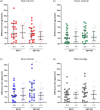Gafchromic EBT3 film provides equivalent dosimetric performance to EBT-XD film for stereotactic radiosurgery dosimetry
- PMID: 38739345
- PMCID: PMC11408406
- DOI: 10.1007/s13246-024-01430-z
Gafchromic EBT3 film provides equivalent dosimetric performance to EBT-XD film for stereotactic radiosurgery dosimetry
Abstract
The accurate assessment of film results is highly dependent on the methodology and techniques used to process film. This study aims to compare the performance of EBT3 and EBT-XD film for SRS dosimetry using two different film processing methods. Experiments were performed in a solid water slab and an anthropomorphic head phantom. For each experiment, the net optical density of the film was calculated using two different methods; taking the background (initial) optical density from 1) an unirradiated film from the same film lot as the irradiated film (stock to stock (S-S) method), and 2) a scan of the same piece of film taken prior to irradiation (film to film (F-F) method). EBT3 and EBT-XD performed similarly across the suite of experiments when using the green channel only or with triple channel RGB dosimetry. The dosimetric performance of EBT-XD was improved across all colour channels by using an F-F method, particularly for the blue channel. In contrast, EBT3 performed similarly well regardless of the net optical density method used. Across 21 SRS treatment plans, the average per-pixel agreement between EBT3 and EBT-XD films, normalised to the 20 Gy prescription dose, was within 2% and 4% for the non-target (2-10 Gy) and target (> 10 Gy) regions, respectively, when using the F-F method. At doses relevant to SRS, EBT3 provides comparable dosimetric performance to EBT-XD. In addition, an S-S dosimetry method is suitable for EBT3 while an F-F method should be adopted if using EBT-XD.
Keywords: Audit; Dosimetry; EBT-XD; EBT3; Film; Radiochromic film; Stereotactic radiosurgery.
© 2024. Crown.
Conflict of interest statement
The authors have no relevant financial or non-financial interests to disclose.
Figures







References
-
- Kann BH, Park HS, Johnson SB, Chiang VL, Yu JB (2017) Radiosurgery for brain metastases: changing practice patterns and disparities in the United States. J Natl Compr Cancer Netw 15:1494–1502. 10.6004/jnccn.2017.7003 - PubMed
-
- Pudsey L, Haworth A, White P, Moutrie Z, Jonker B, Foote M, Poder J (2022) Current status of intra-cranial stereotactic radiotherapy and stereotactic radiosurgery in Australia and New Zealand: key considerations from a workshop and surveys. Phys Eng Sci Med 45:251–259. 10.1007/s13246-022-01108-4 - PMC - PubMed
-
- Palmer AL, Dimitriadis A, Nisbet A, Clark CH (2015) Evaluation of Gafchromic EBT-XD film, with comparison to EBT3 film, and application in high dose radiotherapy verification. Phys Med Biol 60:8741–8752. 10.1088/0031-9155/60/22/8741 - PubMed
-
- Grams MP, Gustafson JM, Long KM, de los Santos LE (2015) Technical note: initial characterization of the new EBT-XD gafchromic film. Med Phys 42:5782–5786. 10.1118/1.4930058 - PubMed
-
- Khachonkham S, Dreindl R, Heilemann G, Lechner W, Fuchs H, Palmans H, Georg D, Kuess P (2018) Characteristic of EBT-XD and EBT3 radiochromic film dosimetry for photon and proton beams. Phys Med Biol 63:065007. 10.1088/1361-6560/aab1ee - PubMed
MeSH terms
LinkOut - more resources
Full Text Sources
